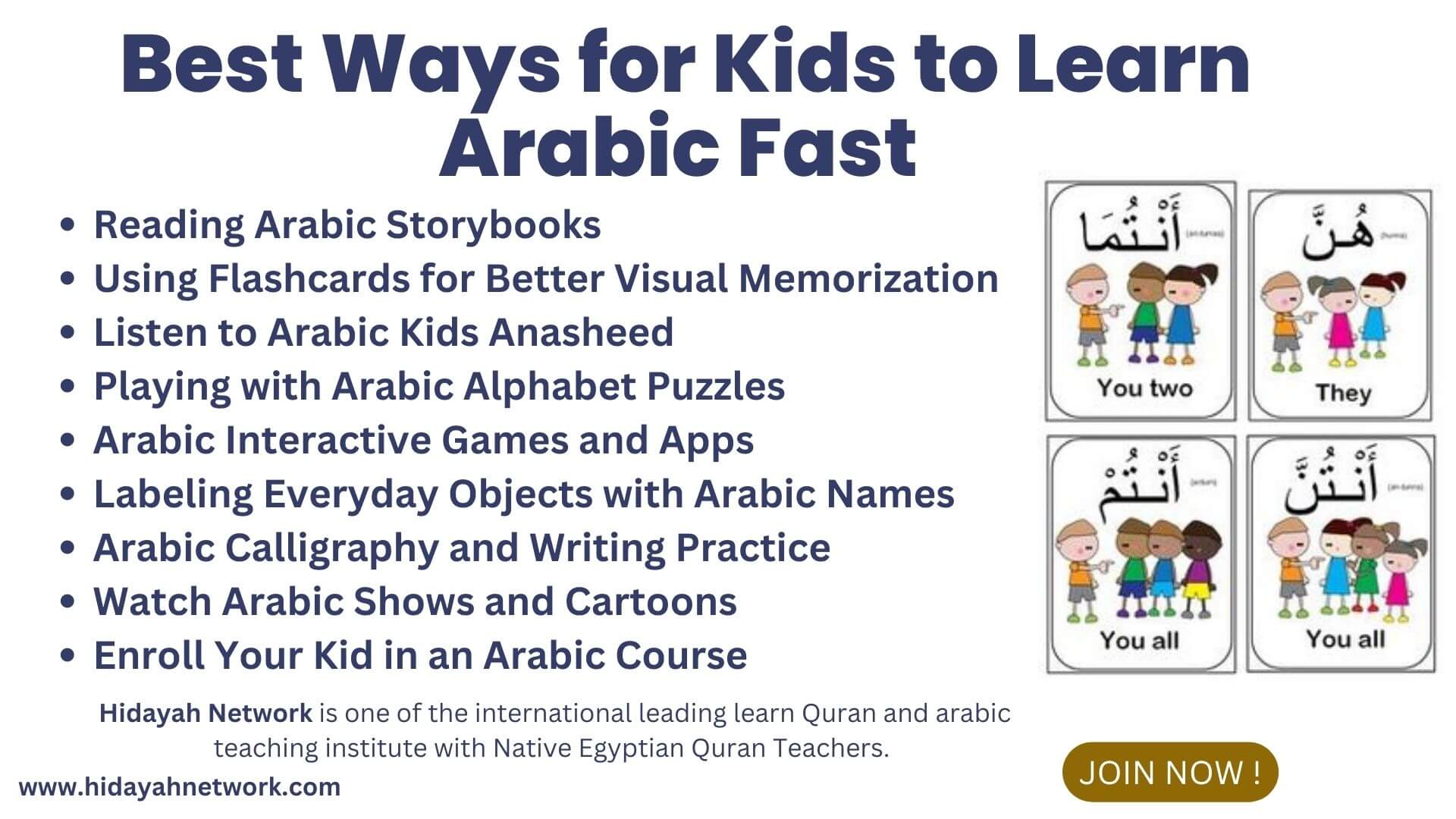Learning Arabic language can be an exciting adventure, but it also comes with its fair share of challenges for parents and kids. However, you don’t need to worry too much. Thankfully, there are expert ways that can help you learn Arabic fast as a kid, ensuring you stay right on your path.
You can start by encouraging your kid to interact with Arabic-speaking kids, have daily conversations with them in Arabic, play Arabic word of the day challenge, watch Arabic cartoons and shows, labeling house objects with Arabic names, and so on. Multiple ways can make your kid learn Arabic fast. So, let’s discover more similar fun activities to learn Arabic for kids that can enable kids to learn quran arabic perfectly.
Table of Contents
Toggle13 Best Ways for Kids to Learn Arabic Fast

1. Encourage Regular Interaction with Arabic-Speaking Kids
Encouraging regular interaction with Arabic-speaking kids is a dynamic approach to accelerating language learning. Organize playdates where your child can engage in natural conversations, fostering a comfortable language environment.
Additionally, encourage sharing snacks and meals, using moments like these to teach simple words like “Tamr” (Dates) and “Halib” (Milk), making the language experience both enjoyable and educational.
- Introduce common greetings like “As-salamu alaykum” to kickstart interactions and create connections.
- Incorporate basic phrases such as “Shukran” and “Sabah al-khayr” into these social settings, ensuring practical usage.
- During playtime, include games that involve Arabic numbers and counting, seamlessly integrating language learning with mathematical concepts.
2. Have Daily Conversations in Arabic with Your Kid

Daily conversations in Arabic with your child establish a consistent language-learning routine. Start with everyday topics like family, hobbies, and activities to make the conversations relatable and engaging. Incorporate phrases like “Ana ohibb” (I like) and “Ana la ohibb” (I don’t like) to express preferences, adding a personal touch to the dialogue.
- Discuss daily routines using phrases such as “Al-Fajr” (Morning) and “Al-Layl” (Night), making language learning a seamless part of their day.
- Bedtime stories in Arabic not only enhance vocabulary but also create a positive association with the language.
Note: By weaving language into daily interactions, your child is more likely to absorb and retain the information, fostering a love for Arabic.
3. Daily Arabic Word-of-the-Day Challenge
The daily Arabic Word-of-the-Day Challenge is an effective strategy to expedite language learning. Introduce a new word each day, such as “Kitab” (Book) or “Sayara” (Car), using visual aids to enhance understanding.
Integrate the chosen word into daily activities, creating real-life associations for practical application. Reinforce the word during meals, bedtime, and playtime, allowing multiple exposures throughout the day. Repeat the word in various contexts, aiding familiarity and retention.
Pro Tip: To motivate your child, celebrate their success with a small reward or praise, reinforcing positive language habits. This challenge not only builds vocabulary but also instills a sense of accomplishment, making language learning an enjoyable daily activity.
4. Daily Family Language Time with Arabic-only Rule
Implementing daily family language time with an Arabic-only rule is a powerful method for immersive learning. Designate specific times, such as mealtime or evening gatherings, for exclusive Arabic conversations.
- Begin with common greetings like “Marhaban” and “Ma’a as-salama” to set the tone for language-focused interactions.
- Introduce basic commands like “Jalis” (Sit) and “Qum” (Stand) during family activities, providing opportunities for practical usage.
- Create a structured routine where family members share their day in Arabic, utilizing phrases like “Ana dhakira” for reflection.
Expert Tip: To add excitement, implement themed days focusing on specific topics, such as colors or animals, using related Arabic vocabulary. This immersive approach ensures a holistic language experience, incorporating Arabic seamlessly into the family’s daily life.
5. Reading Arabic Storybooks
Learning Arabic through storybooks is an engaging journey. Start with simple tales like “حروفي الأولى” (“My First Arabic Alphabet”) by Alia Khaled Al Mazeedi. Begin by identifying the Arabic letters and their sounds – for example, “ألف” (alif) sounds like “a.”
Gradually, move on to more complex narratives like “حكايات الأنبياء” (“Tales of the Prophets”) by Dar Al-Manhal. As you read, underline words like “مدينة” (madina) for “city” and “سفينة” (safeena) for “ship.”
Take time to understand the context of the stories and how words are used. Create a small notebook to jot down new words and their meanings, reviewing them regularly.
6. Using Flashcards for Better Visual Memorization
Flashcards are your visual aid for mastering Arabic vocabulary. Write down words like “شجرة” (shajara) for “tree” and “كتاب” (kitaab) for “book” on one side, and draw or print pictures that represent these words on the other side. It’s one of the easiest ways to learn Arabic.
- Practice regularly, going through the cards and associating words with images.
- For the Arabic alphabet, work on a few letters each week.
- Take “ب” (baa) for instance; write it out repeatedly, saying the sound aloud as you do.
- Use a mnemonic device – imagine the shape resembling a “baseball bat” for “baa.”5. Incorporate these flashcards into your daily routine, and watch your vocabulary expand and your Arabic skills grow.
7. Listen to Arabic Kids Anasheed

Music is a wonderful tool for learning Arabic quickly and joyfully. You can play songs like Alif Ba Ta, which is the most well-known Arabic children’s song in the Arab world. The song’s title relates to the first three letters of the Arabic alphabet, which are similar to the English ABC.
For many years, Alif Ba Ta has been utilized in Arabic lessons. The song introduces each letter of the Arabic alphabet to youngsters simply and engagingly.
When you hear “الله” (Allah), think of “God.” As you sing along, you’re not only enjoying the melody but also internalizing Arabic phrases.
Include these anasheed in your playlist and make it a habit to listen to them regularly. With consistent exposure, you’ll find yourself speaking Arabic with greater fluency and understanding.
8. Playing with Arabic Alphabet Puzzles
Engaging children with Arabic alphabet puzzles is a playful and effective way to introduce them to the language. Provide colorful puzzles featuring Arabic letters, like “Alif” and “Baa,” making the learning process visually stimulating.
- Encourage your child to arrange the puzzle pieces in order, associating each letter with its unique shape and sound.
- Incorporate simple words that start with each letter, such as “Tufah” (Apple) for “Ta” and “Bint” (Girl) for “Ba,” fostering vocabulary growth.
This hands-on approach not only enhances their understanding of the Arabic alphabet but also makes learning enjoyable and interactive.
In Arabic group classes, teachers visualize each letter’s shape, associating it with its sound. Over time, students not only recognize Arabic letters but also write and pronounce them confidently.
9. Arabic Interactive Games and Apps
Interactive apps are your dynamic Arabic learning companions.
- Install “ألعاب تعلم اللغة العربية” (“Arabic Language Learning Games”) by Kids Learn Arabic Games.
- Begin with simple games that match words to images, like “قمر” (qamar) for “moon.”
Choose age-appropriate games that introduce basic Arabic words and phrases, such as “Salam” (Peace) and “Hajar” (Rock). Interactive storytelling apps can further immerse kids in Arabic narratives, expanding their language comprehension.
- Look for apps that incorporate games like matching Arabic words with images or simple quizzes to reinforce learning.
- Make screen time educational by selecting apps that provide immediate feedback.
10. Labeling Everyday Objects with Arabic Names
Transform your surroundings into a language-learning playground by labeling everyday objects with their Arabic names. Begin with simple items like “باب” (baab) for “door” and “نافذة” (nafeza) for “window.”
- Place labels on common items around the house, such as “Seeb” (Apple) on the fruit bowl and “Bab” (Door) on the entranceways.
- Encourage your child to read these labels daily, reinforcing the association between the object and its Arabic name.
- Extend this practice to their belongings, using labels like “Kitab” (Book) on their reading materials.
- Gradually increase the complexity of objects, introducing new words like “سرير” (sareer) for “bed.”
Attach the labels where you’ll see them often, creating constant exposure to Arabic vocabulary. As you encounter these items throughout the day, say their Arabic names out loud.
11. Arabic Calligraphy and Writing Practice
Dive into the artistic world of Arabic calligraphy to enhance your writing skills. Begin with basic strokes that form letters – practice the curve of “س” (seen) and the loop of “ج” (jeem).
As you become comfortable with individual letters, try writing short words like “كتاب” (kitaab) for “book” and “زهرة” (zahra) for “flower.”
Use lined paper to ensure proper letter alignment. Explore online resources that provide step-by-step guides for forming each letter correctly. Learning arabic calligraphy is best best way where anyone can learn Arabic to understand quran.
12. Watch Arabic Shows and Cartoons
Learning can be both entertaining and educational when you watch Arabic shows and cartoons. Start with animated series like “SpongeBob” dubbed in Arabic.
Listen closely to the characters’ conversations, picking out familiar words and phrases. As you watch, you might hear “شكراً” (shukran) for “thank you” and “مرحباً” (marhaban) for “hello.”
Consider using subtitles in Arabic initially to aid comprehension. Make it a weekly habit to watch Arabic content, gradually transitioning to shows with more complex dialogues and scenarios.
13. Enroll Your Kid in an Arabic Course
If you’re looking for structured guidance, enrolling your child in online Arabic classes for kids is a strategic step. In Arabic classes, individuals can choose a course designed for kids. There are courses that offer age-appropriate lessons that cover reading, writing, speaking, and listening skills.
Guided by experienced instructors, your child will receive personalized attention and engage in interactive activities that foster language acquisition.
What is the Fastest Way for a Kid to Learn Arabic?
The fastest way for a kid to learn Arabic involves immersive methods.
- Foster regular dialogue for constant language exposure.
- Utilize apps designed for interactive Arabic learning sessions.
- Integrate language through playful and educational games.
- Explore engaging narratives for language comprehension and enrichment.
- Associate Arabic words with familiar items in daily surroundings.
- Participate in groups for interactive language experiences.
- Create fun, themed activities for diverse language applications.
How Can a Kid Memorize Arabic Words Fast?
To help a kid memorize Arabic words quickly, employ engaging techniques.
- Enhance recall with visuals and consistent repetition.
- Use games to make learning Arabic words engaging and fun.
- Involve touch, sight, and sound for comprehensive language understanding.
- Reinforce word memorization through visual and interactive flashcards.
- Acknowledge achievements to boost motivation and confidence.
- Watch Arabic cartoons or sing songs for contextual language exposure.
- Regularly integrate Arabic words into daily routines for continuous reinforcement.
How Quickly Can a Kid Learn Arabic?
Learning Arabic is a pleasant effort that demands a major time commitment. According to research, acquiring proficiency in Arabic normally requires over 2200 hours or around 88 weeks of sustained study effort.
Consider the situation of committing an hour every day to Arabic study. The route to fluency in this example would take around 1-1.5 years. However, implementing the best Arabic language learning techniques.
Conclusion
Hidayah Network hopes these tips for kids to learn Arabic were helpful. Through the magic of storybooks, flashcards, anasheed melodies, and interactive apps, the path to proficiency comes alive. Engaging with Arabic alphabets via puzzles and embracing the rhythmic charm of anasheed songs fosters a connection that lingers.
Adding a creative flair with calligraphy and stepping into the realm of Arabic shows, the journey becomes an immersive adventure. Moreover, enrolling in courses offers expert guidance while labeling everyday objects will help make your kid speak Arabic fast










